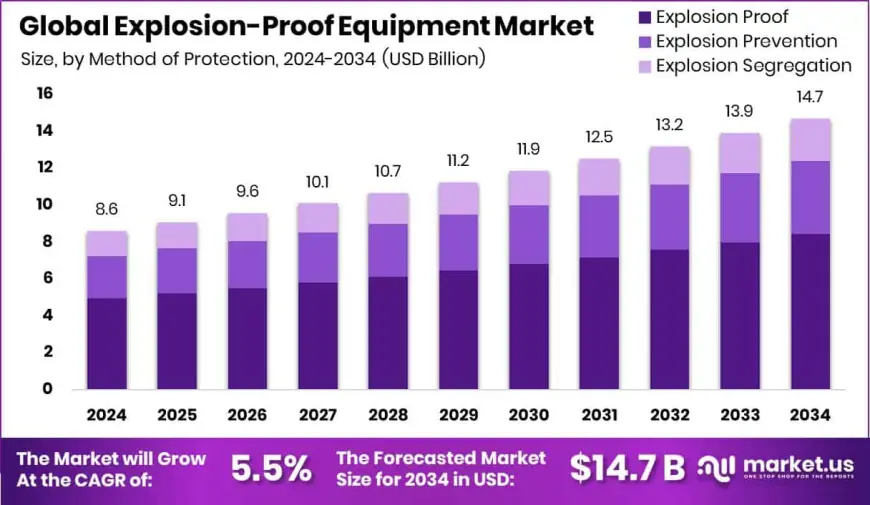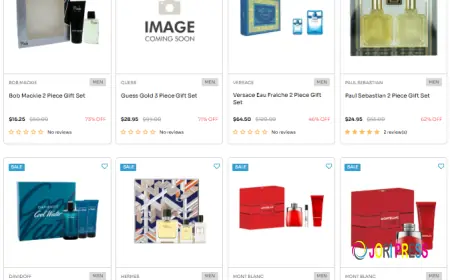Explosion-Proof Equipment Market Dynamics: Forecasts and Trends
The Global Explosion-Proof Equipment Market is expected to be worth around USD 14.7 billion by 2034, up from USD 8.6 billion in 2024, and grow at a CAGR of 5.5% from 2025 to 2034. With a 34.8% share, the North America Explosion-Proof Equipment market stood at USD 2.9 Bn.

Report Overview:
The global explosion-proof equipment market is projected to climb from USD 8.6 billion in 2024 to USD 14.7 billion by 2034, posting a steady CAGR of 5.5 % during the 2025–2034 period. The “explosion-proof” method dominated by sturdy enclosures and protective housings holds the largest method segment share at 57.4 %, credited to widespread trust in its reliability across hazardous industries. Within zoned hazard classifications, Zone 1 leads, representing 31.2 % of market share, reflecting frequent usage in areas where explosive atmospheres are common. Among end-use sectors, oil & gas accounts for 29.3 % of global demand in 2024, underscoring the heavy reliance on explosion‑proof gear in upstream and downstream operations. Geographically, North America dominates with a 34.8 % share (USD 2.9 billion) in 2024, driven by stringent safety standards and heavy industrial infrastructure.
This market is fueled by industries where safety is non-negotiable such as mining, chemicals, pharmaceuticals, and especially oil & gas where any ignition source can be catastrophic. The dominance of the explosion-proof method signals industries' preference for tried-and-tested protective measures. Zone 1 dominance highlights continual demand in moderately high-risk areas. Growth is strongest in North America, yet Asia-Pacific is also emerging due to expanding energy and manufacturing sectors. The next decade looks bright, with equipment manufacturers focused on compliance with global standards (ATEX, IECEx, NEC/CEC) and with R&D pushing forward innovations in materials, design, and integration with smart monitoring systems. Operational efficiency and safety regulations remain key drivers, as companies invest in capital projects requiring high-specification, certified gear. Spillover from heightened environmental, health, and safety (EHS) policies further reinforces the market’s long-term stability and visibility.
Key Takeaways
-
Market size growing from USD 8.6 billion to USD 14.7 billion (2024–2034), a 5.5 % CAGR.
-
Explosion‑proof protection leads method share at 57.4 %, chosen for robustness.
-
Zone 1 applications capture 31.2 % of the market, reflecting frequent use in moderately hazardous settings.
-
Oil & gas sector is the top end-user with 29.3 % share.
-
North America is the largest region at 34.8 %, worth USD 2.9 billion.

Download Exclusive Sample Of This Premium Report:
https://market.us/report/global-explosion-proof-equipment-market/free-sample/
Key Market Segments:
By Method of Protection
- Explosion Proof
- Explosion Prevention
- Explosion Segregation
By Zone
- Zone 0
- Zone 20
- Zone 1
- Zone 21
- Zone 2
- Zone 22
By End-use
- Oil and Gas
- Pharmaceutical
- Chemical and Petrochemical
- Energy and Power
- Mining
- Others
DORT Analysis
Drivers
-
Stringent regional safety regulations (NEC, IECEx, ATEX) demand certified equipment.
-
High growth in oil & gas, mining, and petrochemical industries requiring explosion-safe assets.
-
Rising industrial automation increases need for reliable protective enclosures and certified devices.
-
Greater awareness around workplace safety and large-scale CAPEX investments pushing upgrades.
Opportunities
-
Expansion in APAC regions (e.g., India, China) amid rising energy and manufacturing investments.
-
Digitization wave: integrating sensors and predictive maintenance into explosion-proof solutions.
-
Retrofit demand from aging plants seeking modern, certified upgrades.
-
Customization prospects in sectors like pharmaceuticals and food processing with unique safety needs.
Restraints
-
High upfront costs and long certification cycles hamper adoption, especially in smaller projects.
-
Complex international standards and certification timelines slow product rollouts.
-
Competition from alternative safety techniques (e.g., intrinsic safety, segregation methods).
-
Global supply chain disruptions may delay delivery of specialized components and raw materials.
Trends
-
Growing inclination toward “smart explosion-proof” devices with IoT-enabled monitoring.
-
Use of lighter, high-performance materials to reduce weight without compromising safety.
-
Modular and scalable explosion‑proof enclosures tailored for diverse industrial needs.
-
Shift toward integrated solutions (lighting, control systems) that simplify installation and maintenance.
-
Sustainability push driving interest in energy-efficient, eco-friendly explosion-proof systems.
Market Key Players:
- Adalet
- Siemens
- Honeywell International Plc.
- Rockwell Automation Inc.
- ABB
- Eaton Corporation
- Emerson Electric Co.
- Warom Technology Inc.
- WorkSite Lighting
- Extronics Ltd.
- Alloy Industry Co., Ltd
- Tomar Electronics Inc
- Potter Electric Signal Co. LLC
- Federal Signal Corporation
- Pepperl+Fuchs SE
Conclusion:
What's Your Reaction?
 Like
0
Like
0
 Dislike
0
Dislike
0
 Love
0
Love
0
 Funny
0
Funny
0
 Angry
0
Angry
0
 Sad
0
Sad
0
 Wow
0
Wow
0



















































